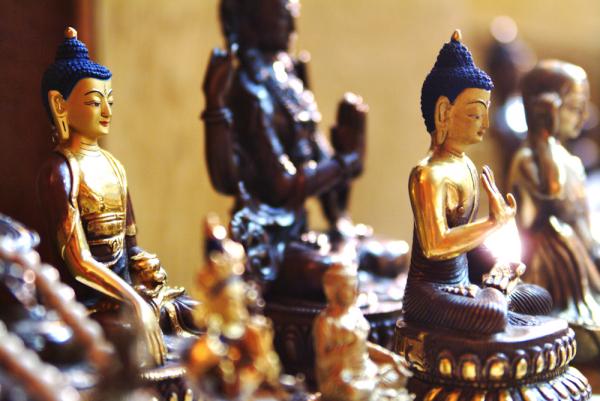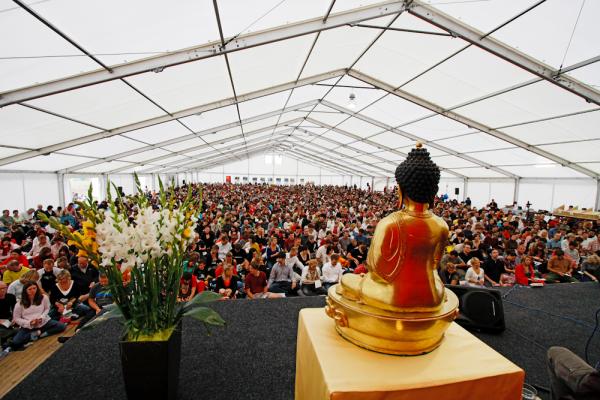
Buddha
The historical Buddha Shakyamuni was born around 560 B.C.E. to a royal family. From early childhood, he was surrounded by wealth and beauty, and enjoyed a sophisticated education. The texts describe him as tall, strong, and blue-eyed. When he was 29 years old, he left the palace for the first time and encountered an old person, a sick person, and a dead person, experiences he had never known before. He then realized that nothing was permanent and left his palace to meditate in the mountains and forests of Northern India. After a 6-year search for lasting meaning, he recognized the nature of mind while in deep meditation and reached enlightenment in what is Bodh Gaya in Northern India today.
Buddha teaches about ultimate and conditioned existence in a way that makes Buddhism directly relevant to our daily lives. Understanding this makes the experience of lasting happiness possible. Buddhism does not proclaim dogmas; rather, it encourages critical questioning. Using the right meditations, the intellectual understanding of the teachings becomes a personal experience. Additional methods solidify what is reached in meditation. The goal of Buddha's teachings is the full development of the innate potential of body, speech, and mind. Through his teachings, Buddha is seen as a timeless mirror of mind's inherent potential.
The Buddha's teachings, which make beings fearless, joyful, and kind, are the main religion in several East Asian countries. Since the early seventies, the profound Buddhist view with its vast number of methods has inspired and fascinated a growing number of people in Western cultures.

Buddha's Teachings
The Buddha enjoyed unique circumstances for passing on his teachings. Born into a highly developed culture, he was surrounded by exceedingly gifted people. After reaching enlightenment, he shared his methods for discovering the mind for a full 45 years. It is for this reason that his teachings, called the Dharma, are so vast. The Kanjur, Buddha's own words, consists of 108 volumes containing 84,000 helpful teachings. Later commentaries on these, the Tenjur, amount to another 254 equally thick books. This makes Buddha's final evaluation of his life understandable: "I can die happily. I did not hold one single teaching in a closed hand. Everything that may benefit you I have already given." His very last statement sets Buddhism apart from what is otherwise called religion: "Now, don't believe my words because a Buddha told you, but examine them well. Be a light onto yourselves." Such statements show the practical approach of Buddhism which is meant for real life. When people asked Buddha why and what he taught, he replied: "I teach because you and all beings seek happiness and try to avoid suffering. I teach "the way things are."
So, what is Buddhism? "Buddha used the best description himself. During the 1,500 years the teachings existed in India, they were called Dharma, and for the last 1,000 years in Tibet, the name was Cho. Both mean 'the way things are'. Understanding 'the way things are' is the key to every happiness. Buddha himself is both teacher, example, protector and friend. His help allows beings to avoid suffering and to enter a state of increasing bliss while also liberating and enlightening others." - Lama Ole Nydahl
The Buddha gave methods by which full enlightenment may be attained. In a way that makes Buddhism directly relevant to our lives, he explained what exists ultimately and what is conditioned. The Buddha showed his students how to use all experiences in life as steps towards enlightenment, giving teachings which lead to deep and lasting happiness. He encouraged his students to be sceptical, inviting them to thoroughly check for themselves whether his teachings were dogmatic or truly liberating. Buddhist meditation methods can generate powerful inner change enabling experiences to be integrated directly towards enriching our lives. These skillful methods allow the levels of consciousness already reached through meditation to become anchored in a way that they are never again lost.
Buddha's highest teaching, Vajrayana, involves the deep transformation of body, speech and mind. It moves on from the level of concepts and ideas to complete identification with enlightenment and spontaneous activity. Vajrayana allows us to open to the experience of total non-separation between subject, object and action. Acting from this level one does whatever brings growth, meaning and joy.

Karma
Karma is the universal law of cause and effect, meaning, that what we experience now is a result of our previous actions of body, speech and mind; and what we will experience in the future is determined by our current actions. This knowledge naturally encourages us to act in a meaningful way and to help others as much as we can.
Karma is not a fate. The understanding that each of us is responsible for our own lives, makes it possible to consciously generate positive impressions, which brings happiness and helps us to avoid the causes of future suffering. Positive states of mind may be strengthened effectively through the methods of the Vajrayana, while negative impressions waiting to mature, can be transformed into wisdom. It is important to remember that accumulation of positive karma is instrumental in the beneficial circumstances for the future practice to arise. In the similar way the purification of negative karma eliminates obstacles to Dharma practice.